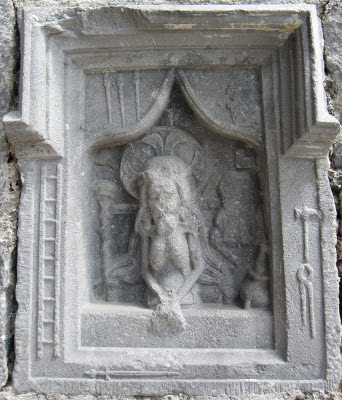 |
| The old Franciscan Friary, Ennis, Ireland |
 |
| A new roof over the nave |
The old friary was disestablished by Henry VIII during the English Reformation and later passed into Church of Ireland ownership. It fell into much disrepair in the following centuries, though it was still in use as a Protestant church as late as the 19th century. It is undergoing repair and preservation at the moment.
In the nave there is an interesting sculpted panel depicting Christ being presented by Pilate to the crowds. The famous Ecce Homo (behold the man!) scene of John 19:5. The panel depicts Christ stripped and bound. Around him the panel is filled with the instruments of His passion. Most of the symbols are obvious (the nails, the pillar, the dice, the seamless garment etc.). Some are less obvious. The top right panel depicts a hand holding a clump of hair (cf. Isaiah 50.6).
The Ecce Homo panel at the old Ennis friary was intended to help the faithful reflect on the passion of Christ. It's an emotive scene replicated countless times in Christian art. D. A. Carson, in his commentary on John's Gospel gave the following reflection on Christ standing before his accusers,
 |
| The Ecce Homo panel at Ennis Friary |
"Once more Pilate steps out of the praetorium to address the Jews. He delivers his verdict, and then dramatically presents Jesus—a sorry sight, swollen, bruised, bleeding from those cruel and ridiculous thorns. Aware as he is that it is the people who must choose the man who will receive the governor’s amnesty, he presents Jesus as a beaten, harmless and rather pathetic figure to make their choice of him as easy as possible. In his dramatic utterance Here is the man! (in Latin, Ecce homo!), Pilate is speaking with dripping irony: here is the man you find so dangerous and threatening: can you not see he is harmless and somewhat ridiculous? If the governor is thereby mocking Jesus, he is ridiculing the Jewish authorities with no less venom. But the Evangelist records the event with still deeper irony: here indeed is the Man, the Word made flesh. All the witnesses were too blind to see it at the time, but this Man was displaying his glory, the glory of the one and only Son, in the very disgrace, pain, weakness and brutalization that Pilate advanced as suitable evidence that he was a judicial irrelevance."

Someone tweeted link to this post and I stumbled upon it that way. I'm also from Ennis an actually spent a summer as a guide in the old friary. How does an Ennisman end up in TX?
ReplyDeleteHi Martin,
DeleteIt's nice to get feedback from a fellow Ennisman!
I'm studying for my Masters in theology at the moment in Dallas Theological Seminary. I've been in the US for two years now.